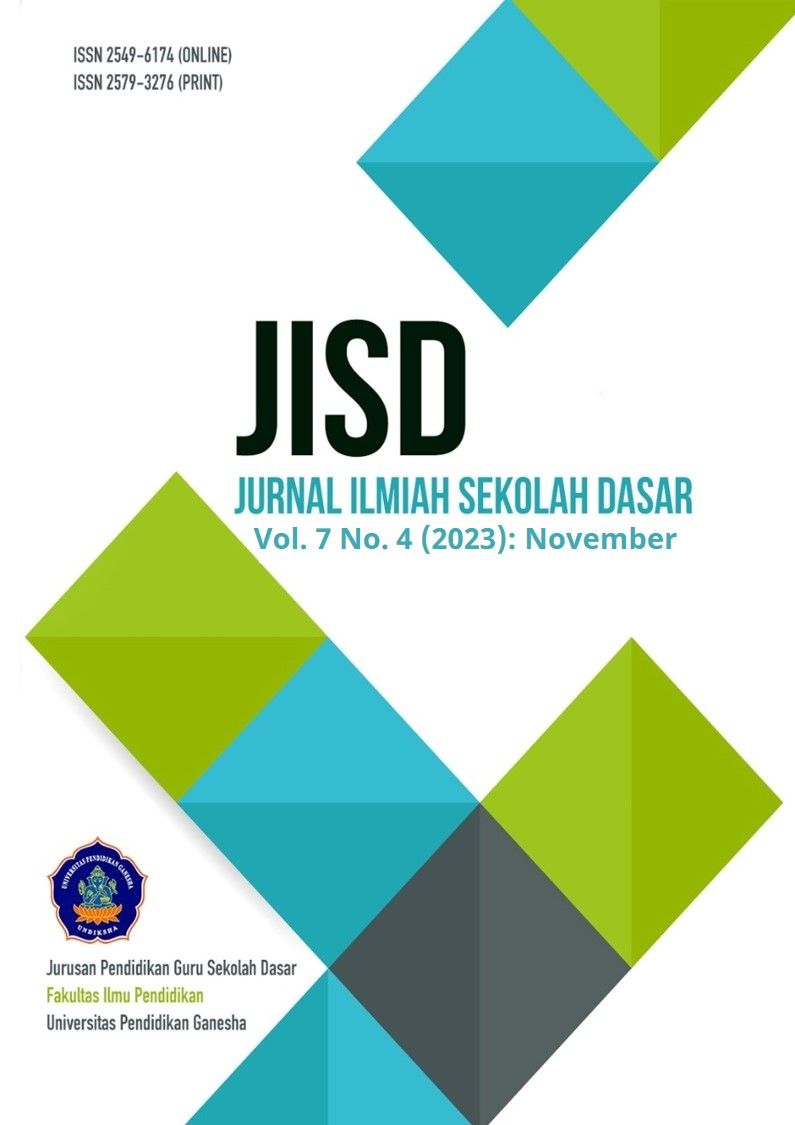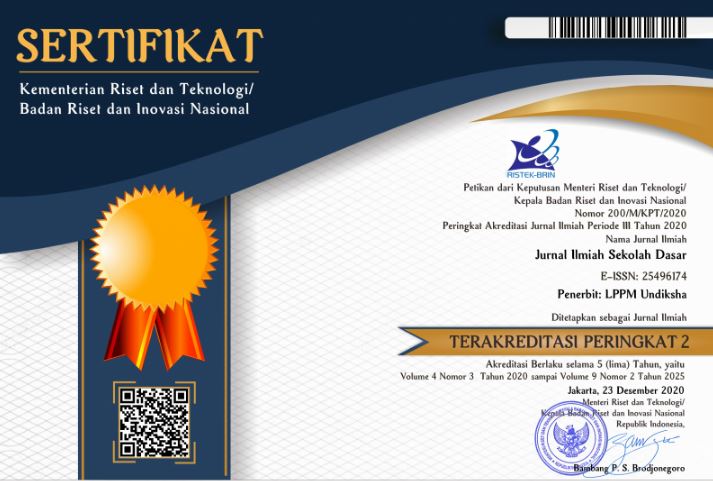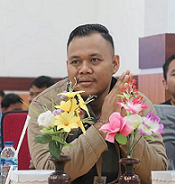Friday Shodaqoh in the Growth of Social Awareness in Formal Education Institutions
DOI:
https://doi.org/10.23887/jisd.v7i4.57811Keywords:
Friday Shodaqoh, Attitude, Social AwernessAbstract
The problem that became the basis of this study is the anti-social attitude of a person after the government's policy for social distancing due to the covid-19 pandemic two years ago. Friday shodaqoh activities is one of the routine activities once a week in formal institutions. The purpose of this study is to analyze grow caring attitudes for students in formal institutions. A descriptive qualitative method is used in this study, which is directed at knowing the analysis of Friday shodaqoh in fostering students' social awareness attitudes. As for the meeting technique conducted by researchers through questionnaires and interviews, researchers then analyzed the results of questionnaires and interviews. Then after the data is collected, the data is tested for validity through triangulation of sources and techniques. The results showed that the activities of Shodaqoh Friday become the bridge for students in school in the growth of developing social awareness attitudes. Forms of social care attitudes include attitudes of devotion, perspectives to help each other, kindship attitudes, loyal attitudes, caring attitudes, democratic attitudes, attitudes of cooperation, disciplinary attitudes, attitudes of tolerance, and empathy. This study implies that it can be used as input for the government, stakeholders, leaders, and teachers in implementing Friday shodaqoh activities so that the quality of education is better by prioritizing the success of student outcomes. Implementing Friday shodaqoh activities built in formal institutions is expected to finish the institution's success in printing generations with a social awareness attitude.
References
Agustini, F. (2020). Integrasi Nilai Karakter Melalui Permainan Tradisional Tarik Tambang Dalam Pembelajaran IPA. Jurnal Ilmiah Sekolah Dasar, 4(2), 114–120. https://doi.org/10.23887/jisd.v4i2.24513. DOI: https://doi.org/10.23887/jisd.v4i2.24513
Amani, M., Nazifi, M., & Sorkhabi, N. (2020). Parenting styles and academic achievement of early adolescent girls in Iran: mediating roles of parent involvement and self-regulated learning. European Journal of Psychology of Education, 35(1), 49–72. https://doi.org/10.1007/s10212-019-00422-y. DOI: https://doi.org/10.1007/s10212-019-00422-y
Amin, S., Sumarmi, Bachri, S., Susilo, S., Mkumbachi, R. L., & Ghozi, A. (2022). Improving Environmental Sensitivity Through Problem-Based Hybrid Learning (Pbhl): an Experimental Study. Jurnal Pendidikan IPA Indonesia, 11(3), 387–398. https://doi.org/10.15294/jpii.v11i3.38071. DOI: https://doi.org/10.15294/jpii.v11i3.38071
Amma, T., Setiyanto, A., & Fauzi, M. (2021). Problematika Pembelajaran Pendidikan Agama Islam Pada Peserta Didik. Edification Journal, 3(2), 135–151. https://doi.org/10.37092/ej.v3i2.261. DOI: https://doi.org/10.37092/ej.v3i2.261
Anggarini, W. R., & Listyaningsih. (2020). Tingkat Kepedulian Sosial Peserta Didik Pada Anak Berkebutuhan Khusus (ABK) di SMPN 2 Buduran. Kajian Moral Dan Kewarganegaraan, 08(02), 779–793. https://doi.org/10.26740/kmkn.v8n2.p779-793.
Asmahasanah, S., Ibdalsyah, I., & Sa’diyah, M. (2018). Social Studies Education in Elementary Schools Through Contextual REACT-Based on Environment and Sociopreneur. International Journal of Multicultural and Multireligious Understanding, 5(6), 52. https://doi.org/10.18415/ijmmu.v5i6.487. DOI: https://doi.org/10.18415/ijmmu.v5i6.487
Ayu Anjarwati, A., Novi Primiani, C., & Pujiati. (2021). Penyusunan E-Modul Sistem Imun Kelas Xi Berbasis Potensi Alam Lokal Menggunakan Aplikasi Book Creator Pada Pembelajaran Daring. Prosiding Seminar Nasional Sains Dan Teknologi, 1(1), 115–121. https://publikasiilmiah.unwahas.ac.id/index.php/PROSIDING_SNST_FT/article/view/5099.
Bonnett, M. (2012). Environmental concern, moral education and our place in nature. Journal of Moral Education, 41(3), 285–300. https://doi.org/10.1080/03057240.2012.691643. DOI: https://doi.org/10.1080/03057240.2012.691643
Bosica, J., Pyper, J. S., & MacGregor, S. (2021). Incorporating problem-based learning in a secondary school mathematics preservice teacher education course. Teaching and Teacher Education, 102, 103335. https://doi.org/10.1016/j.tate.2021.103335. DOI: https://doi.org/10.1016/j.tate.2021.103335
Brambilla, M., Biella, M., & Kret, M. E. (2019). The power of pupils in predicting conforming behavior. Social Influence, 14(2), 40–49. https://doi.org/10.1080/15534510.2019.1637775. DOI: https://doi.org/10.1080/15534510.2019.1637775
Danastri, N., & Desiningrum, D. (2016). Eksplorasi Pengalaman Stress Pada Individu Yang Berperilaku Bruksisme (Studi Kualitatif Dengan Pendekatan Fenomenologis). Empati, 604–609. https://doi.org/https://doi.org/10.14710/empati.2016.15402. DOI: https://doi.org/10.14710/empati.2016.15402
De Klerk, J. J. (2019). Leading transitions in traumatically experienced change – a question of doing or being? Journal of Organizational Change Management, 32(3), 340–355. https://doi.org/10.1108/JOCM-04-2017-0099. DOI: https://doi.org/10.1108/JOCM-04-2017-0099
Dere, Z. (2019). Investigating the Creativity of Children in Early Childhood Education Institutions. Universal Journal of Educational Research, 7(3), 652–658. https://doi.org/10.13189/ujer.2019.070302. DOI: https://doi.org/10.13189/ujer.2019.070302
Dryfoos. (1997). Prevalensi perilaku masalah: Implikasi untuk program. Dalam RP Weissberg, TP. Gullotta, RL Hampton, BA Ryan, & GR Adams (Eds.), Anak sehat 2010: Meningkatkan kesehatan anak. 17–46.
Durlak, J. A., Weissberg, R. P., Dymnicki, A. B., Taylor, R. D., & Schellinger, K. B. (2011). The Impact of Enhancing Students’ Social and Emotional Learning: A Meta-Analysis of School-Based Universal Interventions. Child Development, 82(1), 405–432. https://doi.org/10.1111/j.1467-8624.2010.01564.x. DOI: https://doi.org/10.1111/j.1467-8624.2010.01564.x
Gnambs, T., & Kaspar, K. (2014). Disclosure of sensitive behaviors across self-administered survey modes: a meta-analysis. Behavior Research Methods, 47(4), 1237–1259. https://doi.org/10.3758/s13428-014-0533-4. DOI: https://doi.org/10.3758/s13428-014-0533-4
Harianingsih, I., & Jusoh, Z. (2022). A review of studies on cooperative learning in language classroom seen from students’ attitudes. International Journal of English and Applied Linguistic, 2(1), 62–74. https://jurnal.itscience.org/index.php/ijeal/article/download/1423/1000. DOI: https://doi.org/10.47709/ijeal.v2i1.1423
Horne, C., & Irwin, K. (2016). Metanorms and antisocial punishment. Social Influence, 11(1), 7–21. https://doi.org/10.1080/15534510.2015.1132255. DOI: https://doi.org/10.1080/15534510.2015.1132255
Jager, T. De, & Africa, S. (2023). How Can Educators Effectively Be Trained to Teach Coding and Robotics in STEAM Field Programs ? 35(1), 1–12. https://doi.org/10.23917/varidika.v1i1.20840.
Kabiri, S., Choi, J., Kruis, N., Shadmanfaat, S. M., & Lee, J. (2022). Social Concern as a Means of Understanding the Risk of Workplace Deviance. Deviant Behavior, 43(8), 939–958. https://doi.org/10.1080/01639625.2021.1942328. DOI: https://doi.org/10.1080/01639625.2021.1942328
Kardinus, W. N., Akbar, S., & Rusfandi. (2022). Implementasi Program Pendidikan Karakter Untuk Membangun Sikap Kepedulian Sosial. Jurnal Penelitian Dan Pendidikan IPS, 16(1), 31–40. https://doi.org/10.21067/jppi.v16i1.6971.
Kassem, M. A. M. (2018). The Effect of Using Blackboard on English Majors’ Writing Proficiency and Attitudes. International Journal of Applied Linguistics and English Literature, 7(6), 73. https://doi.org/10.7575/aiac.ijalel.v.7n.6p.73. DOI: https://doi.org/10.7575/aiac.ijalel.v.7n.6p.73
Lambert, V. a., & Lambert, C. E. (2013). Qualitative Descriptive Research: An Acceptable Design. Pacific Rim International Journal of Nursing Research, 16(4), 255–256. https://he02.tci-thaijo.org/index.php/PRIJNR/article/download/5805/5064.
Manullang, K. K. B. (2017). Pengaruh Intensitas Penggunaan Jejaring Sosial dan Kematangan Emosi Terhadap Kepedulian Sosial. Psikoborneo: Jurnal Ilmiah Psikologi, 5(4), 479–485. https://doi.org/10.30872/psikoborneo.v5i4.4465. DOI: https://doi.org/10.30872/psikoborneo.v5i4.4465
Mardiah. (2019). Tujuan Pendidikan Dalam Al-Qur’an. Jurnal Al-Liqo, 4(1), 90–107. https://doi.org/10.46963/alliqo.v4i1.18. DOI: https://doi.org/10.46963/alliqo.v4i1.18
Nahdiyatul Husna, & Herwati. (2022). Internalisasi Kegiatan “Jum’at Shodaqoh” dalam Membentuk Sikap Kepedulian Sosial Siswa MA Nahdlatul Ulama’ Kraksaan Probolinggo. Jurnal Mu’allim, 4(2), 187. https://doi.org/10.35891/muallim.v4i2.3077. DOI: https://doi.org/10.35891/muallim.v4i2.3077
Ni’mah, A. (2022). Upaya Guru dalam Meningkatkan Kreativitas Berpikir Peserta Didik di Sekolah Dasar. Jurnal Penelitian Dan Pengembangan Pendidikan, 6(2), 173–179. https://doi.org/10.23887/jppp.v6i2.48157. DOI: https://doi.org/10.23887/jppp.v6i2.48157
Nurdin, R. (2020). Multikulturalisme Dalam Tinjauan Al Qur’an. Journal of Learning Education and Counseling, 3(1). https://doi.org/10.31960/ijolec.v3i1.561. DOI: https://doi.org/10.31960/ijolec.v3i1.561
Nurindarwati, R., Mulyoto, M., & Hasyim, D. (2022). Evaluation model of character education programs in Islamic religious education and moral education learning at SMP negeri I Surakarta. Journal Research of Social, Science, Economics, and Management, 1(9), 1453–1472. https://doi.org/10.36418/jrssem.v1i9.152. DOI: https://doi.org/10.36418/jrssem.v1i9.152
Oktari, S. W., Atmaja, H. T., & Rc, A. R. (2019). The Interaction of Learning Model and Learning Style in Improving Students Learning Outcomes. Journal of Primary Education, 8(5), 206–216. https://journal.unnes.ac.id/sju/index.php/jpe/article/view/32148.
Putri, D. P. (2018). Pendidikan Karakter Pada Anak Sekolah Dasar di Era Digital. Jurnal Pendidikan Dasar, 2(1), 37–50. https://doi.org/http://dx.doi.org/10.29240/jpd.v2i1.439. DOI: https://doi.org/10.29240/jpd.v2i1.439
Rismayani, L. D., Kertih, I. W., & Sendratari, L. P. (2020). Penanaman Sikap Sosial Melalui Pembelajaran Ips Pada Siswa Kelas Vii Smp Negeri 2 Singaraja. Jurnal Pendidikan IPS Indonesia, 4(1), 8–15. https://doi.org/10.23887/pips.v4i1.3164. DOI: https://doi.org/10.23887/pips.v4i1.3164
Roebianto, A. (2020). The Effects of Student’s Attitudes and Self-Efficacy on Science Achievement. Jurnal Pengukuran Psikologi Dan Pendidikan Indonesia (JP3I), 9(1), 1–10. https://doi.org/10.15408/jp3i.v9i1.14490. DOI: https://doi.org/10.15408/jp3i.v9i1.14490
Shadmanfaat, S. M., Choi, J., Kabiri, S., & Lee, J. (2021). Impact of Social Concern on Cyberbullying Perpetration in Iran: Direct, Indirect, Mediating, and Conditioning Effects in Agnew’s Social Concern Theory. Deviant Behavior, 42(11), 1436–1457. https://doi.org/10.1080/01639625.2020.1753152. DOI: https://doi.org/10.1080/01639625.2020.1753152
Shin, J., Lee, Y. kyung, Park, S., & Seo, E. (2019). Young individuals’ consideration of goal-self alignment and its relations to goal commitment and social concern: age differences and similarities. Self and Identity, 18(6), 650–667. https://doi.org/10.1080/15298868.2018.1510850. DOI: https://doi.org/10.1080/15298868.2018.1510850
Siti Rodi’ah, I. H. (2021). Strategi Pembelajaran Pendidikan Jasmani Berbantu Media Book Creator Digital Dalam Meningkatkan Kemampuan Motorik Kasar Siswa Pada Tingkat Sekolah Dasar. Continuous Education: Journal of Science and Research, 2(2), 23–35. https://doi.org/10.51178/ce.v2i2.225. DOI: https://doi.org/10.51178/ce.v2i2.225
Soekarno, B., & Mujiwati Sri, E. (2015). Peningkatan Nilai Kepedulian Sosial Melalui Modifikasi Model Pembelajaran Konsiderasi Pada Mahasiswa Tingkat I Program Studi PGSD FKIP Universitas Nusantara PGRI Kediri. Jurnal Pendidikan Karakter, 26, 35–36. https://doi.org/10.29407/e.v2i2.85.
Tabi’ain, A. (2017). Menumbuhkan Sikap Peduli Pada Anak Melalui Interaksi Kegiatan Sosial”. IJTIMAIYA: Journal of Social Science Teaching, 1. http://journal.iainkudus.ac.id/index.php/Ijtimaia/article/download/3100/2309. DOI: https://doi.org/10.21043/ji.v1i1.3100
Williams, E., Woods, J. M., Hertelendy, A., & Kloepfer, K. (2019). Supervisory influence: Subordinate development of crisis leader potential in an extreme context. Journal of Organizational Change Management, 32(3), 320–339. https://doi.org/10.1108/JOCM-10-2017-0373. DOI: https://doi.org/10.1108/JOCM-10-2017-0373
Winarno, A., Fedin, M. Y. A., & Salleh, N. H. M. (2022). the Effect of Technological Literacy, Learning Facility, and Family Environment on Students’ Learning Motivation. Jurnal Pendidikan: Teori, Penelitian, Dan Pengembangan, 7(7), 246. https://doi.org/10.17977/jptpp.v7i7.15404. DOI: https://doi.org/10.17977/jptpp.v7i7.15404
Wiyani, N. A., & Setiani, R. E. (2022). Manajemen Program Jum’at Bersedekah untuk Membentuk Karakter Anak Usia Dini. PAUD Lectura: Jurnal Pendidikan Anak Usia Dini, 5(02), 24–36. https://doi.org/10.31849/paud-lectura.v5i02.9603. DOI: https://doi.org/10.31849/paud-lectura.v5i02.9603
Wood, C. (2017). Ritual well-being: toward a social signaling model of religion and mental health. Religion, Brain and Behavior, 7(3), 223–243. https://doi.org/10.1080/2153599X.2016.1156556. DOI: https://doi.org/10.1080/2153599X.2016.1156556
Zaluchu, S. E. (2020). Strategi Penelitian Kualitatif dan Kuantitatif di dalam Penelitian Agama. Evangelikal: Jurnal Teologi Injili Dan Pembinaan Warga Jemaat, 28(1), 28–38. https://doi.org/10.46445/ejti.v4i1.167. DOI: https://doi.org/10.46445/ejti.v4i1.167
Downloads
Published
How to Cite
Issue
Section
License
Copyright (c) 2023 Husnul Khotimah atim

This work is licensed under a Creative Commons Attribution-ShareAlike 4.0 International License.
Authors who publish with the Journal Ilmiah Sekolah Dasar agree to the following terms:
- Authors retain copyright and grant the journal the right of first publication with the work simultaneously licensed under a Creative Commons Attribution License (CC BY-SA 4.0) that allows others to share the work with an acknowledgment of the work's authorship and initial publication in this journal.
- Authors are able to enter into separate, additional contractual arrangements for the non-exclusive distribution of the journal's published version of the work (e.g., post it to an institutional repository or publish it in a book), with an acknowledgment of its initial publication in this journal.
- Authors are permitted and encouraged to post their work online (e.g., in institutional repositories or on their website) prior to and during the submission process, as it can lead to productive exchanges, as well as earlier and greater citation of published work. (See The Effect of Open Access)










